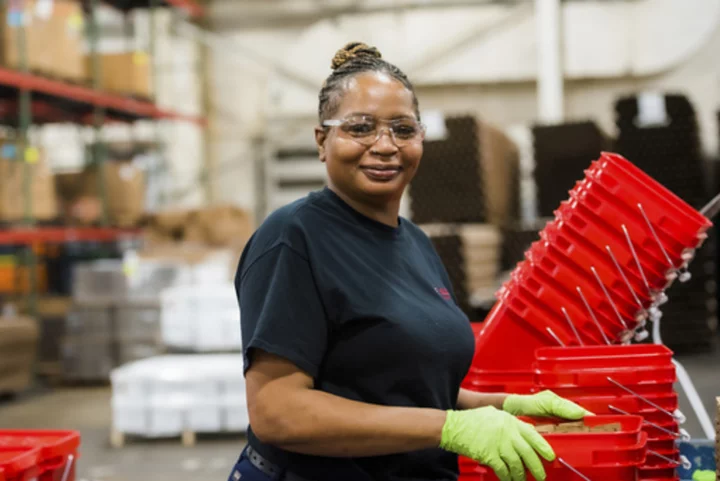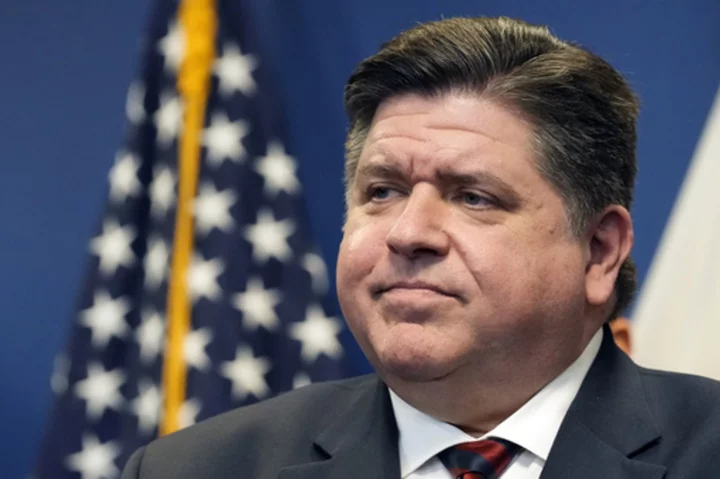CLEVELAND (AP) — Mary Lamar had been searching for a job that was a good fit.
She worked for a time as a nursing assistant but found it boring. A stint as a shipyard welder ended because she could no longer bear the winter cold. Then Lamar had what she described as a “rift” in her life. That rift led her to plead guilty to robbery in 2019 and to serve time in prison.
Now Lamar, who lives in Cleveland, operates a stamping press, churning out thousands of specialty metal washers each day at Talan Products, a local manufacturer.
“I’ve always been mechanically inclined,” she said. “My mom told me I should have been an engineer.’’
Lamar got her job through a program developed by business and community leaders — with help from philanthropy — to match people of color, women, and formerly incarcerated people with manufacturing jobs.
Manufacturers in Cleveland and other cities, including Buffalo, Chicago, and Milwaukee, are dealing with a retiring workforce that’s left thousands of jobs unfilled. Nationally, the industry’s job gap is projected to hit 2 million by 2030, according to the National Association of Manufacturers. The Cleveland region has an estimated 10,000 manufacturing job openings.
By diversifying their job ranks, Cleveland-area manufacturers also hope to improve communities left behind as plants closed or moved to the suburbs. And now with $5 million in federal stimulus money, they expect to help create thousands of new manufacturing jobs over the next few years.
Philanthropy is investing millions of dollars in the Manufacturing Advocacy & Growth Network, a Cleveland nonprofit consulting group that’s leading the hiring push. The nonprofit offers adult training and high-school internships. The Cleveland Foundation has given $2.5 million as a capital building grant to the nonprofit and to help it set up the internships.
A dozen other foundations contributed about $4 million of the $18.5 million to help build the nonprofit’s new headquarters and training center. It opened in October in one of Cleveland’s poorest neighborhoods. The remainder of the funding came from state and local governments, companies, and individuals.
Giving from foundations and nonprofits groups has leveraged millions of dollars in public funds, said Ethan Karp, CEO of the manufacturing nonprofit.
“You can see this unique role of philanthropy,” he said. “Without it, there would be no (manufacturing) partnership, and none of those government monies would have come earlier.”
The nonprofit has helped manufacturers here hire several hundred employees and interns in recent years. While that’s not nearly enough to ease the job crunch, a major expansion is underway with plans to train and hire about 3,000 workers by 2025 using the federal stimulus money. The plan is to quickly expand the number of job trainees and high school internships.
“Single companies cannot provide holistic community solutions,” Karp said. “You need civic engagement, and you need companies working together. The role we play is to bring those companies together with the trainers, with the transportation companies, with local governments, and with the social-service organizations.”
MANUFACTURING JOB CRUNCH
Manufacturing remains an economic pillar in Northeast Ohio, despite a half century of plant closings and layoffs. The industry still employs more than 270,000 workers in a 21-county region, but it struggles to find enough workers. Most job openings are entry-level, but others are in engineering, computing, and data analysis.
A national emphasis on college over vocational education has squeezed the pipeline of talent to the industry, which many still perceive as a dark and dirty business, even with the rise of automation and technology. Meanwhile, some communities in large manufacturing cities have little access or exposure to the industry even as they experience higher rates of unemployment and underemployment.
“It’s hard to imagine a life that you have no visibility of or no access to,” Karp said. “There’s a lot of untapped potential that doesn’t even know a career in manufacturing exists. It’s an issue for them, but it’s also an issue for manufacturing as well that they’re not getting the best talent that they could.”
Lamar learned about the Access to Manufacturing Careers training program while she was living in a halfway house after her release from prison. The program, launched three years ago, pays trainees $14 an hour as they learn the fundamentals. Lamar is among 113 of the program graduates who have gotten manufacturing jobs, according to the nonprofit.
Another program supported by the Cleveland Foundation is the manufacturing nonprofit’s high-school internship program, Early College, Early Career. Students like high-school senior Kyren Lewis divide time between school and training. Lewis works at Lincoln Electric, a welding-equipment manufacturer. He’s among 29 students, including five women, enrolled in the paid internship program.
Students attend weekly classes at the new center that prepare them for entry-level manufacturing jobs, while also working part time at area companies. Over all, 92 students have graduated from the program since 2017, with 80% receiving job offers.
Training in manufacturing lifts the job skills of Clevelanders, builds wealth, and makes the city’s work force more attractive to business, said Bishara Addison, director of job preparation for the Fund for Our Economic Future, an alliance of funders that contributed to the new center and helps fund the manufacturing nonprofit’s operations.
Manufacturing job-training programs in the disadvantaged communities around the country should see a boost under the Biden administration, which is overseeing large investments in roads and bridges, semiconductor production, and clean energy, said Michelle Burris of the Century Foundation, a progressive think tank.
MIDWESTERN SUCCESS
Some programs are already seeing success. Chicago’s nonprofit Jane Addams Resource Corporation has placed 274 people in manufacturing jobs since 2017. Their training included welding, 3-D printing and computer-controlled machining. The nonprofit has expanded its job training program to Baltimore and Rhode Island.
Like the Cleveland nonprofit, the Chicago program offers supporting services, such as a job coach and emergency cash assistance before and after trainees are hired by manufacturers.
“We focus on long-term outcomes for our clients,” said Danielle Hoske, director of development and communications for Jane Addams. “We want to really build a life of financial stability and security.”
At the Northland Workforce Training Center in Buffalo, nearly 900 students have earned certificates or associate degrees in manufacturing and energy-related industries. About 85% of its graduates are hired and earn an average salary of $40,000, according to information provided by the center.
In Milwaukee and across Wisconsin, the Wisconsin Regional Training Partnership is a network of manufacturers, construction companies, and unions that provide training and apprenticeships. Hundreds of young adults, women and people of color have landed jobs with an average salary of $48,500, according to the network’s website.
“Companies need people, and they’re willing to do more than they normally would to look in places they haven’t looked before,” Karp said. “There’s a beautiful confluence of having the right outcomes in terms of tackling racial and economic disparities and achieving good business outcomes.”
Lamar says she appreciates the training that helped her land her job, and she plans to stick with this job.
“Coming from where I came from, I had no clue of how to run a press,” Lamar said. “I was a welder with very little experience in machining. So being able to learn and accomplish a lot of stuff that has to do with the press, that was the greatest fulfillment.”
____
This article was provided to The Associated Press by the Chronicle of Philanthropy. Reporting for this article is part of a Chronicle of Philanthropy fellowship with local news organizations and was underwritten by a Lilly Endowment grant to enhance public understanding of philanthropy. The Land is solely responsible for the content in this article. The AP and the Chronicle receive support from the Lilly Endowment for coverage of philanthropy and nonprofits. For all of AP’s philanthropy coverage, visit https://apnews.com/hub/philanthropy.









